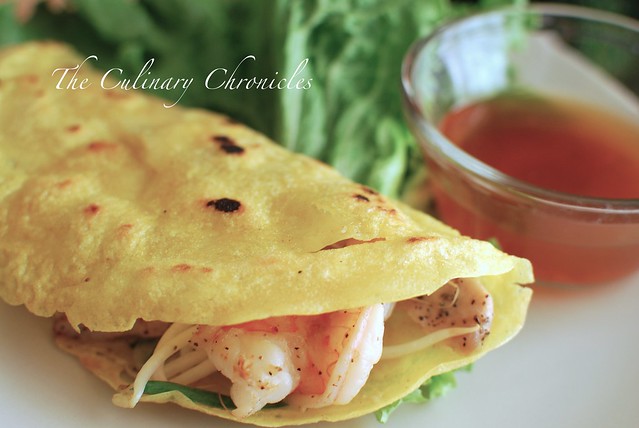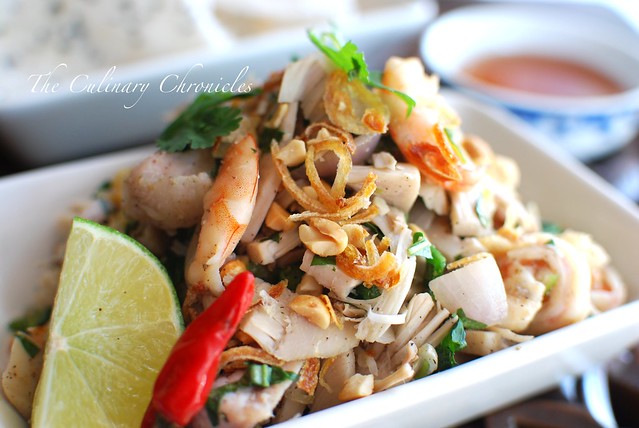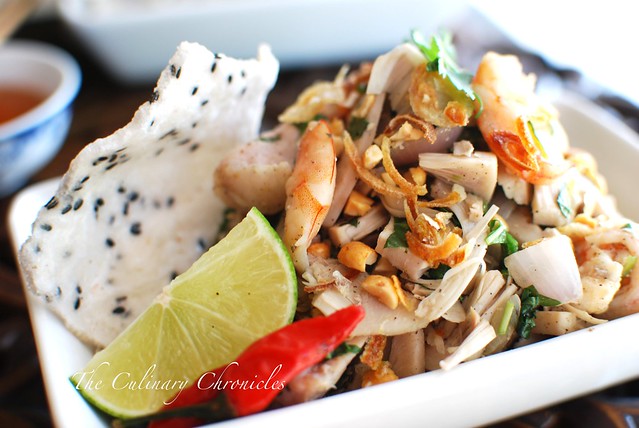
It’s been my absolute pleasure to host this month’s Delicious Vietnam which was founded by Anh of A Food Lover’s Journey and Kim and Hong of Ravenous Couple. I am thankful to have met new bloggers through this process and I am greatly excited to see a thriving love and passion for Vietnamese cuisine!
This month features mouth-watering dishes that vary from Savory to Sweet delights. Get those tummies ready because here we go!
Savory Fare:
From Hanoi, Vietnam: Chi Anh Dao of Door To My Kitchen shares Vietnamese Pan-Fried Tofu Chi Anh Dao says:
“The best way to eat Fried Tofu is fresh out of the pan – golden, crispy and bubbling hot, dipped into Vietnamese fish sauce with chopped scallions. I could eat it just like that with white rice, without anything else.”
 Her amazingly descriptive post of the sounds, smells, and memories connected to this traditional dish will make you run to your kitchens to fry plates of tofu!
Her amazingly descriptive post of the sounds, smells, and memories connected to this traditional dish will make you run to your kitchens to fry plates of tofu!
From Mountain View, CA and Ann Arbor, MI.: The dynamic team of Rau Om shares Caterpillar Bánh Tét (Bánh Tét Sâu Bướm). They say:
“Working from a caterpillar photo, we knew we needed 3 colors: green, orange and black. Green and orange colors were easy: pandan leaf extract and gấc (spiny bitter gourd) are 2 common Vietnamese natural coloring ingredients. Black was a bit more challenging. We gravitated toward squid ink to color the sticky rice black, but we were worried about introducing a seafood taste to our bánh tét. Our other option we decided on was nếp than (black glutinous rice).”
 This whimsical and creative approach to Bánh Tét would be a great way to celebrate the New Year!
This whimsical and creative approach to Bánh Tét would be a great way to celebrate the New Year!
From San Jose, CA: Pauline of Sassy Savvy Travel shares Mom’s Lemongrass Chicken (Gà Xào Xả). Pauline says:
“The perfume of lemongrass sauteed with garlic and onions always made my mouth water. My mom also knew how much I loved the crisp on the slightly seared chicken. It was simple for her to cook, it made the house smell wonderful, and it tasted lovingly homemade.”
 Definitely mouth watering! I can already smell the delicious aromas of the lemongrass!
Definitely mouth watering! I can already smell the delicious aromas of the lemongrass!
From Los Angeles, CA: Hong and Kim of Ravenous Couple shares Vermicelli Fish Soup (Bún Cá). They say:
“It’s a simple vermicelli noodle soup often with a large steak or filet of meaty white fish as well as fish paste meatballs. The broth is pork or chicken stock sweetened with pineapple and tomatoes.”
 This colorful dish epitomizes the flavors of savory, sour, sweet—I can’t wait to give it a try!
This colorful dish epitomizes the flavors of savory, sour, sweet—I can’t wait to give it a try!
From Virginia: Julie of Beginner Mom on the Run shares Beef Phở. Julie says:
“It’s steaming hot and like a aromatic facial when you lean over for the first bite. It’s ideal for any time during the day or night. It will keep your belly full for hours and is light and energizing from the assortment of fresh herbs you personalize you bowl with: basil, bean sprouts, cilantro, culantro, and green onions.”
 I love that Julie chars her yellow onions and ginger to bring out an additional layer of flavors!
I love that Julie chars her yellow onions and ginger to bring out an additional layer of flavors!
From San Diego, CA: Yours Truly of The Culinary Chronicles shares Vietnamese Chicken Glass Noodle Soup (Miến Gà).
“The key to my Miến Gà is homemade chicken stock—something I almost always have on hand. That combined with a splash of what I call “Vietnamese Liquid Gold” and you will have a wonderful and clean broth for your Miến Gà.”
 Whether you’re feeling under the weather or just need the warmth of comfort food, Miến Gà will be perfect for you!
Whether you’re feeling under the weather or just need the warmth of comfort food, Miến Gà will be perfect for you!
Sweet Fare:
From Melbourne, Australia: Anh of A Food Lover’s Journey shares Coconut Ice Cream with Pandan Sticky Rice (Kem Xôi). Anh says:
“My favourite bit of kem xôi was the toasted coconut pieces, which have wonderful nutty and coconut flavor and aroma. I always believe that such addition was the key to make kem xôi special. It was the link to bind the ice-cream together with the sticky rice component of the dish. (And, who can disagree that pandan and coconut are borne for each other?)
 Coconut AND Pandan? Now that’s a winning pair and I just love the various textures that this tempting dessert offers!
Coconut AND Pandan? Now that’s a winning pair and I just love the various textures that this tempting dessert offers!
From Berkeley, CA: Mai of Flavor Boulevard discusses White Canarium or Chinese Olive (Candied Cà-Na). Mai says:
“The first nibble must be executed with caution. It’s firm and sound, with one big hard seed. No wonder the folks at home call the American football the cà na ball: they look and feel the same, only smaller. The flesh is dense like an old coconut’s meat, sour like lemon leaves, yes sweet like licorice blended with a dash of sea salt.”
 According to Mai’s post, Cà Na also has some medicinal properties. Tasty and good for you!
According to Mai’s post, Cà Na also has some medicinal properties. Tasty and good for you!
From Texas: We welcome Mai’s mother of Flavor Boulevard who shares Candied Orange Peel with Pulp (Mứt Cam). She says:
“This candied orange can also be eaten with toast like marmalade, its sweetness stark, its texture crunchy, a natural minty sweep from the peel even gives it a healthy sense. They say eating it helps improving sore throats. I think making it helps improving patience.”
 This Candied Orange Peel seems so inviting that I can almost smell the floral fragrance coming from my screen!
This Candied Orange Peel seems so inviting that I can almost smell the floral fragrance coming from my screen!
From Ashburn, VA: Rosa of saVUry and sweet shares Bánh Tiêu À la Mode. Rosa says:
“I gently tore the bánh tiêu in half and stuffed it with ice cream. IT WAS GOOD. Fried doughy goodness with cool creamy ice cream. It doesn’t have to stop there, coconut ice cream with coconut shavings? Nutella? Durian (if you’re into that, not I)? But for today the vanilla ice cream just hit the spot. Another beautiful harmony of Vietnamese and western cuisine has been born.”
 Fried goodness combined with a creamy, cold treat? Now THAT is a beautiful combination!
Fried goodness combined with a creamy, cold treat? Now THAT is a beautiful combination!
Thank You to everyone who contributed to this month’s delicious spread! I am thrilled by all of this diversity in Vietnamese cuisine and hope that this month’s Delicious Vietnam has inspired you to try out some of these dishes either in your own kitchens or from your local Vietnamese restaurants. 🙂 Cheers and Happy Eating!
Want to join this wonderful event? Come on board! Anh of A Food Lover’s Journey will be hosting for April. Submissions are due April 10th and should be sent to anhnguyen118@gmail.com For more information on hosting or past events, please visit Delicious Vietnam.















































